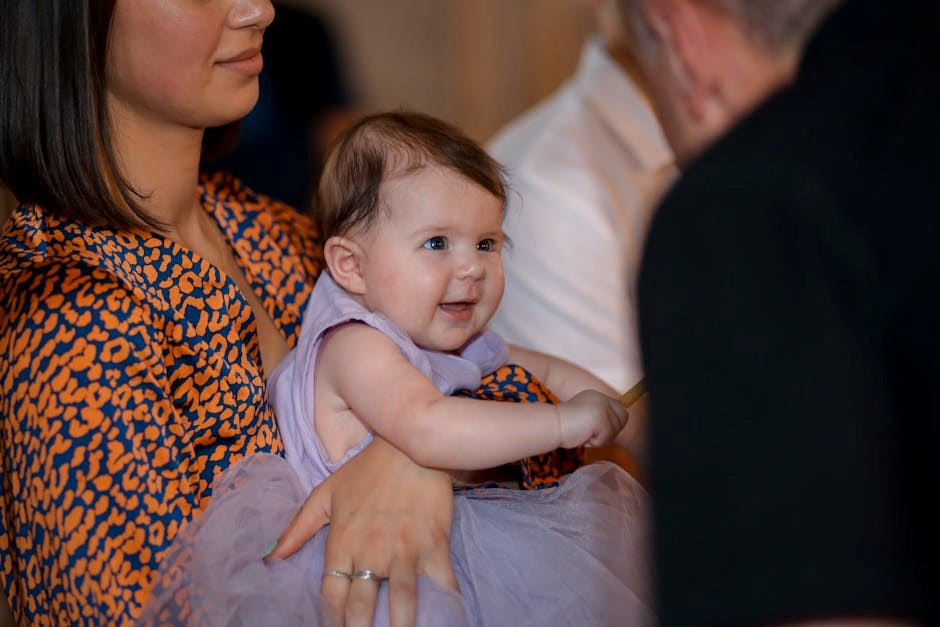temperature guide for baby clothes
- Published
- in Guide
Dressing your baby according to temperature ensures comfort and health. Learn how room temperature, activity levels, and seasonal changes influence clothing choices for optimal thermal regulation.
Understanding the Importance of Proper Clothing for Baby’s Health
Proper clothing is essential for maintaining your baby’s health and comfort. It helps regulate body temperature, preventing overheating or hypothermia. Overdressing can lead to sweating, while underdressing may cause chilling. Both conditions can disrupt your baby’s natural thermoregulation. Signs of discomfort, such as shivering or flushed skin, indicate a need to adjust clothing. Dressing appropriately promotes healthy sleep and overall well-being. Ignoring these signs can lead to potential health risks, making it crucial to choose fabrics and layers suited to the environment and activity level. Ensuring your baby feels comfortable supports their growth and development.
How to Assess Your Baby’s Comfort Based on Room Temperature
Assessing your baby’s comfort involves monitoring room temperature and their physical cues. Touch the nape of their neck or chest to gauge warmth. If it’s too hot, they may sweat or feel flushed. If too cold, their skin may feel cool or clammy. Room temperature should ideally range between 68-72°F (20-22°C) for comfort. Avoid overbundling in warm environments and ensure adequate layers in cooler settings. Pay attention to your baby’s behavior; fussiness or lethargy can signal discomfort. Adjust clothing layers gradually, allowing your baby to acclimate to changes. This approach ensures their environment remains safe and comfortable, promoting healthy growth and restful sleep.
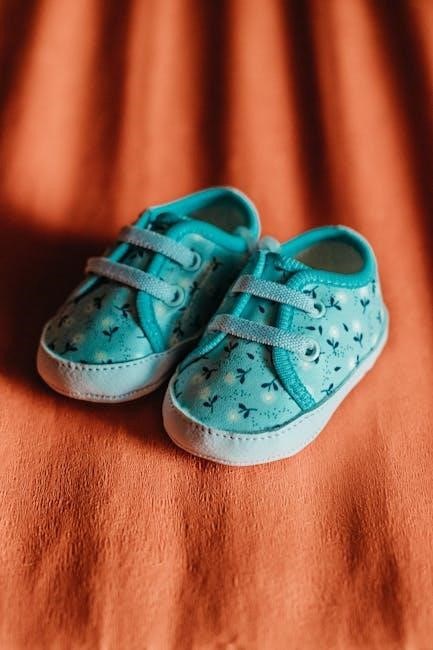
Factors Affecting Baby’s Clothing Choices
Room temperature, activity levels, and seasonal changes are key factors influencing baby clothing choices, ensuring comfort and safety while maintaining appropriate body temperature regulation.
The Role of Room Temperature in Dressing Your Baby
Room temperature plays a crucial role in determining your baby’s clothing needs. A room that is too hot or too cold can lead to discomfort or health risks. Overheating can cause distress, while a chilly environment may lead to hypothermia. Pay attention to your baby’s cues, such as sweating, flushed skin, or shivering, to assess their comfort. Dressing in layers allows you to adjust clothing based on the room temperature, ensuring your baby stays cozy without overloading them. Aim for a room temperature range of 68-72°F (20-22°C) for optimal comfort. Always monitor your baby’s responses to their surroundings to ensure their clothing matches the ambient temperature effectively.
How Your Baby’s Activity Level Impacts Clothing Needs
Your baby’s activity level significantly influences their clothing requirements. For example, during sleep, lightweight, breathable fabrics like cotton are ideal to prevent overheating. During active play, opt for moisture-wicking materials to keep your baby dry and comfortable. Outdoor adventures may require additional layers, such as fleece or waterproof jackets, depending on the weather; Always consider the intensity of the activity and adjust clothing layers accordingly to maintain a stable body temperature. Overdressing can lead to sweating, while underdressing may result in chilling. Observing your baby’s behavior and adjusting their attire based on their activity level ensures optimal comfort and prevents potential health risks associated with extreme temperatures.
Seasonal Considerations for Baby Clothes
Seasonal changes play a crucial role in selecting appropriate clothing for your baby. In colder months, opt for thermal layers, fleeces, and waterproof jackets to protect against harsh weather. During spring and autumn, breathable fabrics like cotton and light knits are ideal, while summer demands lightweight, breathable materials to keep your baby cool. Consider moisture-wicking fabrics for active outdoor play. Additionally, ensure your baby’s sleepwear aligns with the season, using warmer fabrics in winter and lighter ones in summer. Always monitor your baby’s comfort and adjust clothing based on their activity level and room temperature to avoid overheating or chilling, ensuring a stable body temperature year-round.
Dressing Your Baby by Temperature Range
Use temperature ranges to guide your baby’s clothing choices. Layer for cold, balance in mild weather, and opt for breathable fabrics in warmth for comfort and safety.
Cold Weather (Below 50°F/10°C): Layering and Warmth
In cold weather, layering is essential to keep your baby warm and comfortable. Start with a breathable base layer like a onesie or bodysuit, then add a thermal layer if needed. Use a soft, snug-fitting hat, gloves, and socks to prevent heat loss. Opt for materials like merino wool or fleece for warmth. Avoid overbundling, as it can cause overheating. Ensure outdoor gear, such as a thick fleece jacket or snowsuit, is used only when necessary. Always check for signs of discomfort or overheating. For sleep, a warm sleeper or swaddle can be used, but ensure it’s breathable to maintain a safe body temperature. Proper layering helps regulate your baby’s body heat in chilly conditions.
Mild Weather (50°F-70°F/10°C-21°C): Balancing Comfort
In mild weather, focus on breathable fabrics like cotton or bamboo to keep your baby comfortable. Lightweight clothing such as onesies, t-shirts, and light leggings are ideal. Layering is still important, with a base layer and a light sweater or cardigan for cooler moments. Avoid heavy materials that can cause overheating. For outdoor activities, add a light jacket or sweater, but remove layers indoors to prevent sweating. Pay attention to your baby’s cues, ensuring they’re neither too hot nor too cold. This balance ensures your baby stays cozy and content in moderate temperatures, both indoors and outdoors.
Warm Weather (Above 70°F/21°C): Lightweight and Breathable Fabrics
For warm weather, prioritize lightweight and breathable fabrics such as organic cotton, linen, or bamboo. These materials allow airflow and wick moisture, preventing overheating. Opt for simple, loose-fitting clothes like tank tops, short sleeves, and lightweight pants or dresses. Avoid overdressing, as babies can easily overheat in high temperatures. For outdoor protection, use a hat with a wide brim and apply baby-safe sunscreen. Ensure your baby stays hydrated and has plenty of cool fluids available; Light, natural fabrics are key to keeping your baby comfortable and cool during warmer months, both indoors and outdoors.
Essential Clothing Items for Different Temperatures
Onesies, hats, gloves, socks, and lightweight sleepwear are must-haves. These items provide comfort and safety across varying temperatures, ensuring your baby stays cozy year-round.
Onesies and Bodysuits for Layering
Onesies and bodysuits are versatile essentials for layering, providing a snug fit and serving as a base for additional clothing. They ensure breathability and comfort, making them ideal for all seasons. Opt for lightweight, breathable fabrics like cotton for warmer weather and thermal materials for colder conditions. These garments are easy to layer under sweaters, jackets, or sleepwear, adapting to changing temperatures. Many onesies feature convenient snap closures, simplifying diaper changes. They come in various designs, from simple to decorative, offering both practicality and style. A collection of onesies and bodysuits is a must-have for any baby’s wardrobe, ensuring comfort and versatility year-round.
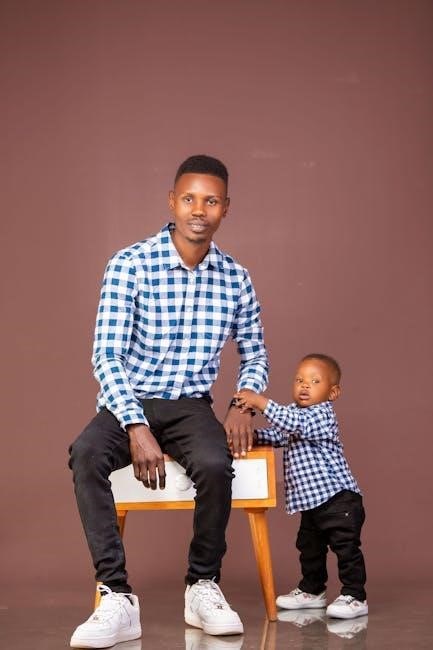
Hats, Gloves, and Socks for Cold Weather
Hats, gloves, and socks are crucial for keeping your baby warm in cold weather, as they prevent heat loss from the head, hands, and feet. Choose materials like cotton, wool, or fleece for their insulating properties. Ensure a snug fit to avoid cold air exposure but avoid tightness that could restrict circulation. Opt for breathable fabrics to prevent overheating, especially during layering. Consider mittens for younger babies to keep hands warm, and layer socks under booties or shoes for added warmth. These accessories are essential for maintaining comfort and preventing hypothermia in chilly conditions, ensuring your baby stays cozy and protected.
Lightweight Sleepwear for Warm Nights
For warm weather, lightweight sleepwear is essential to keep your baby comfortable without overheating. Opt for breathable fabrics like cotton, bamboo, or muslin, which allow air circulation and absorb moisture. Avoid thick or heavy materials that can trap heat. Sleeveless or short-sleeve onesies and lightweight sleepers are ideal for temperatures above 70°F (21°C); Ensure the sleepwear fits snugly but not tightly, promoting ease of movement. Look for moisture-wicking properties to keep your baby dry and cool. Remember, overdressing can lead to overheating, so keep it simple and lightweight to ensure a safe and restful sleep environment for your little one during warm nights.
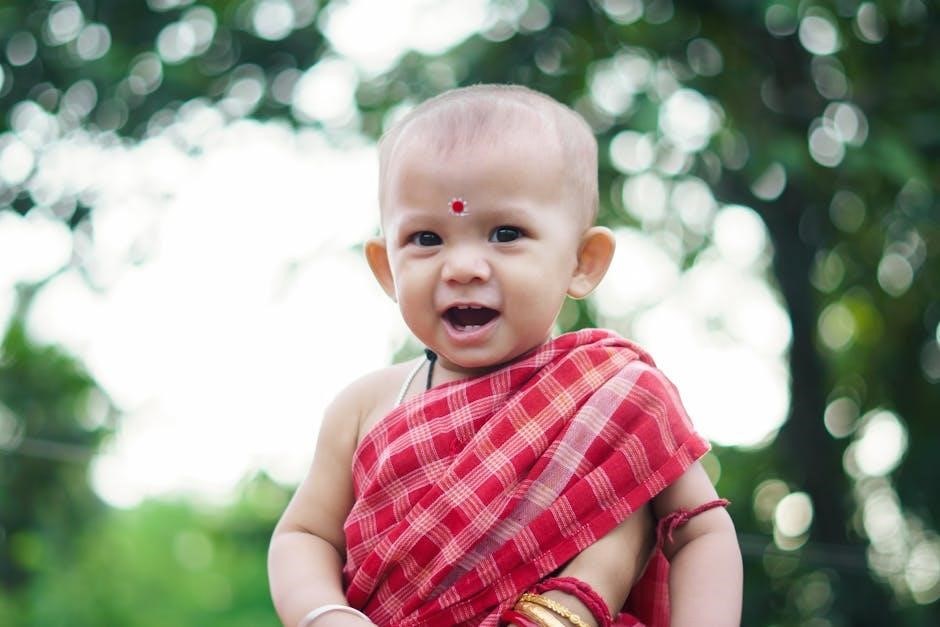
Sleep and Temperature Regulation
Room temperature plays a crucial role in your baby’s sleep comfort. Ensure the environment is neither too hot nor too cold, and dress your baby appropriately to avoid overheating, promoting restful sleep.
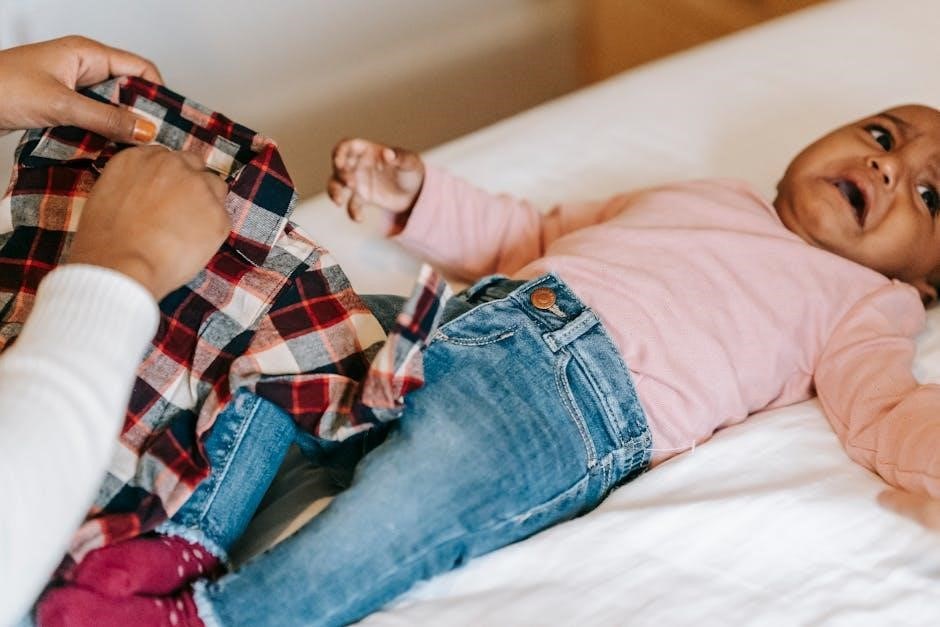
Creating a Safe Sleep Environment: Temperature and Clothing
A safe sleep environment begins with the right temperature and clothing. Keep the room between 68-72°F (20-22°C) to prevent overheating and hypothermia. Dress your baby in lightweight, breathable fabrics like cotton, avoiding heavy blankets or multiple layers. Use a firm mattress and a tight-fitting sheet to reduce suffocation risks. Opt for a sleep sack or lightweight swaddle to maintain comfort without overheating. Avoid placing soft toys or loose bedding in the crib. Ensure your baby’s head is uncovered to promote airflow. Monitor their comfort by checking for sweating on the neck or chest. Proper temperature regulation ensures a restful and secure sleep environment for your baby.
The Best Fabrics for Sleepwear to Promote Comfort
The best fabrics for baby sleepwear are breathable, soft, and moisture-wicking to ensure comfort and regulate body temperature. Cotton is a top choice due to its natural breathability and gentle feel on sensitive skin. Bamboo fabric is another excellent option, as it is lightweight, hypoallergenic, and absorbs moisture effectively. Avoid synthetic fabrics like polyester, which can trap heat and cause discomfort. Opt for organic materials to minimize irritation and ensure safety. Layering with a lightweight onesie under a sleep sack can provide added warmth without overheating. Always choose fabrics that allow airflow to maintain a stable body temperature, promoting peaceful and safe sleep for your baby.

Common Mistakes to Avoid When Dressing Your Baby
Overdressing and the Risk of Overheating
Overdressing can lead to overheating, causing discomfort and potential health risks. Check for warmth by touching the neck, chest, and back. Opt for breathable fabrics like cotton.
Overdressing is a common mistake that can lead to overheating, which may cause discomfort, sweating, and even potential health risks. Babies regulate temperature differently than adults, so it’s essential to monitor their comfort. Signs of overheating include flushed cheeks, excessive sweating, and restlessness. To avoid this, dress your baby in layered, breathable fabrics like cotton, and adjust clothing based on room temperature. Avoid heavy or synthetic materials that trap heat. Always check your baby’s skin by gently touching their back, neck, and chest—these areas should feel warm, not hot. Overheating can disrupt sleep and overall well-being, so staying vigilant is crucial.
Underdressing and the Danger of Hypothermia
Underdressing your baby can lead to hypothermia, a condition where their body temperature drops below normal, potentially causing serious health risks. Signs of hypothermia include shivering, pale or cool skin, and lethargy. Babies lose heat quickly, especially in cold environments, so it’s crucial to dress them appropriately. Always check the room temperature and ensure your baby has enough layers to stay warm. Avoid using thin or inadequate fabrics, especially in colder settings. Touching the back, neck, and chest can help assess their comfort—these areas should feel warm but not overly hot. Proper layering with breathable materials like cotton or merino wool is essential to prevent hypothermia and keep your baby safe and comfortable.

Caring for Baby Clothes to Maintain Quality
Wash baby clothes in gentle cycles with mild detergents to preserve softness and avoid irritation. Avoid bleach and fabric softeners, which can damage materials. Store out-of-season clothes in breathable bags to prevent moisture buildup and maintain freshness.
Washing and Drying Tips for Baby Fabrics
Washing baby clothes requires gentle care to maintain softness and durability. Use mild, fragrance-free detergents to avoid skin irritation. Avoid bleach or fabric softeners, as they can damage fabrics or cause allergic reactions. Wash delicate items separately and inside out to prevent pilling. For drying, opt for air-drying or low heat settings to preserve fabric integrity. Remove clothes as soon as the cycle ends to prevent wrinkles and musty odors. Store clean clothes in a cool, dry place to maintain freshness. Regularly cleaning your washing machine can also prevent residue buildup on fabrics.
Storing Out-of-Season Clothes Properly
Storing baby clothes out of season requires careful organization to maintain their quality. Use breathable, moisture-resistant containers or fabric storage bags to protect against humidity and pests. Ensure clothes are clean and completely dry before storing to prevent mold or mildew. Label containers by size and season for easy access later. Avoid storing clothes in attics or basements with extreme temperature fluctuations. Fold or hang items neatly to prevent wrinkles and creases. Keep stored clothes away from direct sunlight to preserve colors. When retrieving clothes, check for proper fit and cleanliness before use.
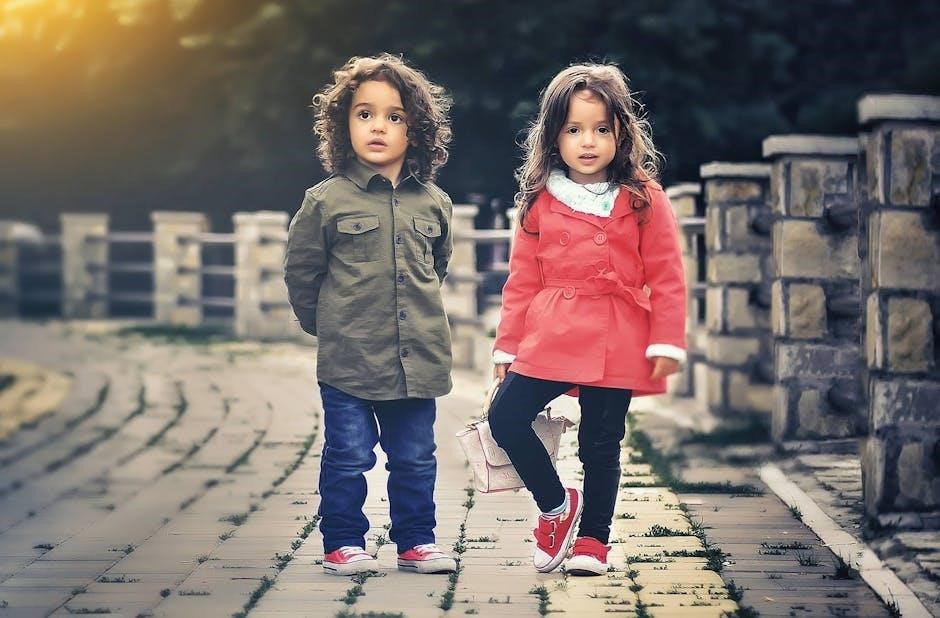
Frequently Asked Questions
How Do I Know If My Baby Is Too Hot or Too Cold?
Check the back of your baby’s neck for sweating (too hot) or coolness (too cold). Ensure their chest and hands feel warm but not overheated.
What Fabrics Are Best for Sensitive Skin?
Opt for soft, breathable fabrics like cotton or bamboo, which are gentle on sensitive skin and regulate body temperature effectively for comfort and health.
To determine if your baby is too hot or cold, gently touch the back of their neck, chest, and hands. A sweaty neck or flushed skin indicates overheating, while cool or clammy skin suggests they may be too cold. Avoid relying solely on their extremities, as hands and feet may feel cool even in a warm baby. Look for behavioral cues: fussiness, arching, or refusing to feed can signal discomfort. Ensure their clothing layers are breathable and adjustable, allowing you to adapt to changing temperatures easily. Always prioritize natural fabrics like cotton for better temperature regulation and comfort.
Natural fabrics such as cotton, bamboo, and linen are ideal for sensitive skin due to their breathability and gentle texture. Cotton is soft and hypoallergenic, making it a safe choice. Bamboo fabric offers antibacterial properties and moisture-wicking abilities, keeping skin dry and comfortable. Linen, with its loose weave, allows excellent airflow, preventing heat buildup. Avoid synthetic fibers like polyester and nylon, which can trap moisture and cause irritation. Opt for untreated, organic fabrics to minimize exposure to harsh chemicals. Consider the season and choose lighter fabrics for warmth and heavier ones for cold. Softness and hypoallergenic qualities are key to preventing skin irritation and ensuring comfort.
